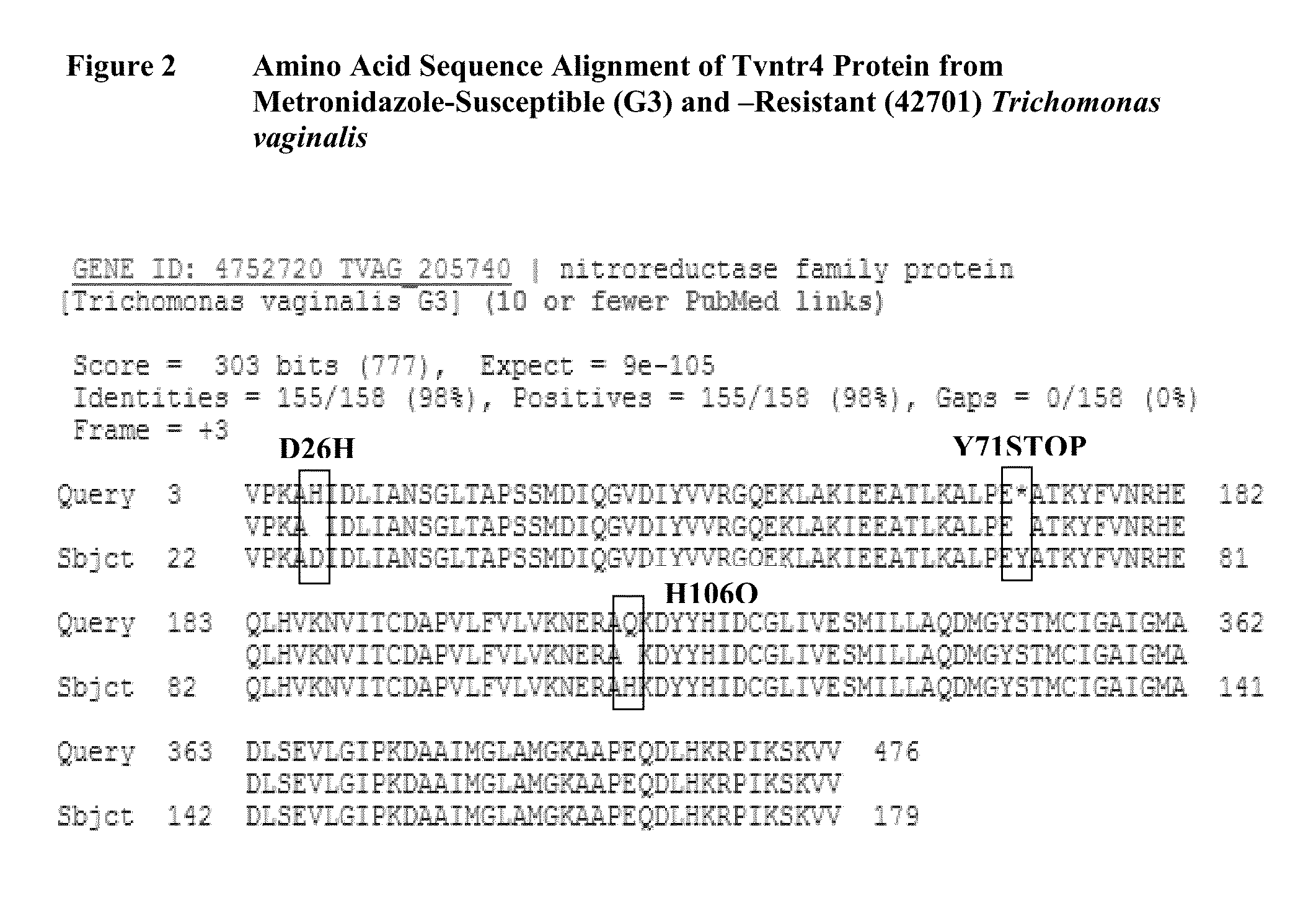Metronidazole resistance in trichomonas vaginalis and single nucleotide polymorphisms
a technology of trichomonas vaginalis and metronidazole, which is applied in the field of diagnostics of trichomonas vaginalis, can solve the problems of requiring weeks to obtain, posing a significant problem to public health, and achieving the effect of reducing healthcare costs, reducing repeated physician visits, and effective patient treatmen
- Summary
- Abstract
- Description
- Claims
- Application Information
AI Technical Summary
Benefits of technology
Problems solved by technology
Method used
Image
Examples
example 1
Sequencing of tvntr Genes Encoding Trichomonas vaginalis Nitroreductase (Tvntr) Proteins
[0101]a) tvntr1-12 genes in Trichomonas vaginalis
[0102]Pal et al. in 2009 described that the Tvntr8 protein reduces and thus activates metronidazole in vitro. Tvntr8 protein is encoded by the tvntr8 gene, which represents one (1) of the 12 Trichomonas vaginalis nitroreductase genes.
[0103]In this study, we sought to sequence all 12 tvntr genes in Trichomonas vaginalis. We selected a total of 100 clinical isolates of Trichomonas vaginalis; namely, 50 metronidazole-susceptible clinical isolates and 50 metronidazole-resistant clinical isolates. These clinical isolates were used to amplify DNA for sequencing. To do so, we extracted the genomic DNA from these clinical isolates by lysis with an anionic detergent (1% SDS and 2% Triton-X 100) followed by extraction with phenol-chloroform and precipitation with ethanol (See, Table 1 in the “Experimental Methods and Protocols” section). Primers (and their ...
example 2
Single Nucleotide Polymorphisms (SNPs) in Trichomonas vaginalis tvntr3, tvntr9 and tvntr10 Genes and their Association with Metronidazole-Resistance
[0109]We examined the validity of the following SNPs as biomarkers for detecting metronidazole-resistant Trichomonas vaginalis. In this study, using the 100 clinical isolates of Trichomonas vaginalis (i.e., fifty (50) metronidazole-resistant isolates and fifty (50) metronidazole-susceptible isolates), we specifically examined the presence of A176T, G199A, G214A, G274A, A385G, T506C and A515C in tvntr3; C2881 and T350C in tvntr9; and T395C in tvntr10 in the clinical isolates. None of these SNPs demonstrated any significant associations with metronidazole resistant Trichomonas vaginalis (See, Table 4). We concluded, based on the selected SNPs in tvntr3, tvntr9, and tvntr10 genes, that these genes do not have an association with metronidazle resistance in Trichomonas vaginalis.
example 3
Single Nucleotide Polymorphisms (SNPs) in Trichomonas vaginalis tvntr4 and tvntr6 Genes and their Association with Metronidazole-Resistance
[0110]We continued to examine the validity of the following SNPs as biomarkers for detecting metronidazole-resistant Trichomonas vaginalis; namely, G76C, C213G and C318A in tvntr4 or A238T, G427C and T476C in tvntr6.
[0111]In this study (as described in Example 2), we used the one-hundred (100) clinical Trichomonas vaginalis isolates (i.e., fifty (50) metronidazole-resistant isolates and fifty (50) metronidazole-susceptible isolates). Resistance or susceptibility of the clinical isolates to metronidazole was determined by broth dilution assay. Isolates with minimum lethal concentration (MLC) values of ≧50 micrograms / milliliter (μg / ml) of metronidazole were considered resistant, whereas isolates with MLC values of ≦25 μg / ml of metronidazole were considered susceptible.
[0112]Cultures were grown and DNA was extracted, as described in Table 1. Table 1...
PUM
 Login to View More
Login to View More Abstract
Description
Claims
Application Information
 Login to View More
Login to View More - R&D
- Intellectual Property
- Life Sciences
- Materials
- Tech Scout
- Unparalleled Data Quality
- Higher Quality Content
- 60% Fewer Hallucinations
Browse by: Latest US Patents, China's latest patents, Technical Efficacy Thesaurus, Application Domain, Technology Topic, Popular Technical Reports.
© 2025 PatSnap. All rights reserved.Legal|Privacy policy|Modern Slavery Act Transparency Statement|Sitemap|About US| Contact US: help@patsnap.com



